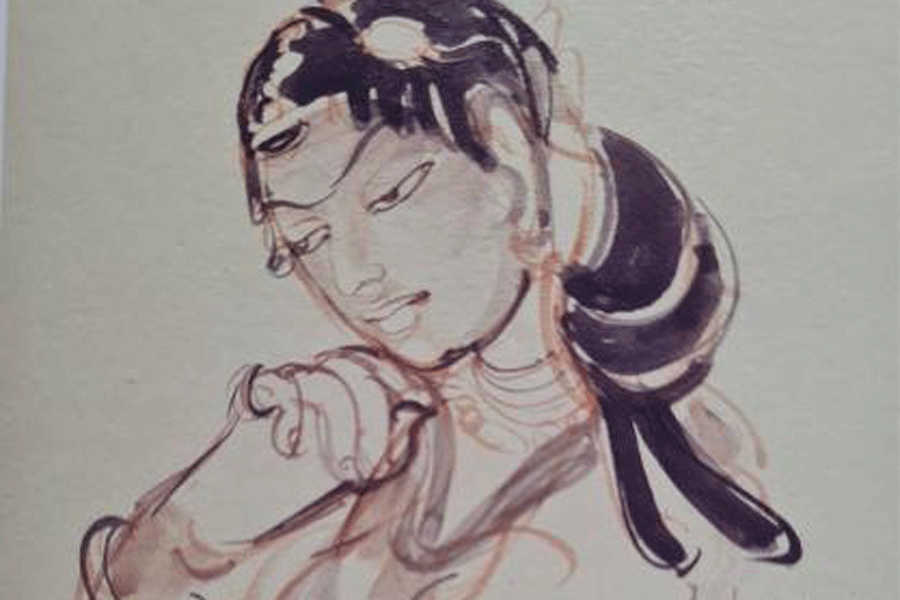Book: DRAWINGS OF AJANTA: AN ARTIST’S INQUEST OF AJANTA MURALS
Author: Ganesh Haloi
Published by: Arun Kumar Bera of Gallery Artistmindz
Price: ₹21,000
The murals of Ajanta — mostly depictions of the Jataka tales — are acknowledged to be some of the greatest art produced by humankind in any century as well as the finest picture gallery to survive from any ancient civilisation. Although the earliest works date back to the second century BCE and the latest ones were created as far back as 480 CE, some of the scenes are still vivid and the colours glowing. But time is a cruel philistine, wreaking havoc on these priceless artworks, not to mention the depredations of nature, wayward tourists, institutional neglect and botched restoration attempts. Hearteningly, several attempts have also been made — beginning with the British and the Nizam of Hyderabad to the Archaeological Survey of India — not only to restore and protect the murals but also to replicate them on paper and archive them in order to save them for posterity. Artists like Nandalal Bose, Asit Kumar Haldar and Samarendra Gupta have been employed to copy the art adorning the walls of the Ajanta caves. These copying exercises soon turned into some of the first drafts of modern Indian art as we know it today.

Representational image. The Telegraph
It was Nandalal Bose’s tales about the Ajanta murals that first sparked Ganesh Haloi’s interest in them. In this exquisitely produced book, Drawings of Ajanta — edited by Arun Ghose and published by Arun Kumar Bera of Gallery Artistmindz — Haloi narrates an interesting anecdote about how his wish to study the murals in the caves ‘miraculously’ came true when he was employed to do just that by the ASI in 1957. His keen eye and inquisitive spirit revealed details that had, till then, gone unnoticed or even been misunderstood. Haloi’s critical gaze spared no one — not even his teacher, Nandalal Bose, whose interpretation of some of the scenes in the murals Haloi later disproved with his meticulous sketches.

Representational image. The Telegraph
Haloi’s fine-line sketches and outlines of the murals make up most of the book — there are 225 pencil and brush drawings and 25 free-hand, colour studies. It is astonishing how effectively simple line-drawings of faces and postures can convey the characters of the different sitters: the alert guard, the king caught in the excitement of the hunt, the obedient son fetching water. Handsome princes and bare-chested nobles abound, while princesses with tiaras of jasmine languish love-lorn on swings and narrow-waisted dancing girls of extraordinary sensuousness perform, dressed only in their jewels and girdles. There are also portraits of bodhisattvas of otherworldly beauty — their eyes half-closed, they sway on the threshold of enlightenment, caught in what the art historian, Stella Kramrisch, wonderfully described as “a gale of stillness”. Haloi examines each bhava, bhangi and mudra as well as every aspect of lasya, laya and abhinaya in the paintings, juxtaposing these with historical evidence — from art and literature — to interpret the scenes that he so masterfully recreates.

Representational image. The Telegraph
Art historians will no doubt find a treasure trove of information in Haloi’s scrupulous and enriching observations about techniques and mediums. Diagrams of the structure of the murals — they consist of four layers, namely the ‘support or the carrier’, the ‘ground’, the ‘priming’ and the ‘paint or pigment’ — and the chemical composition of the gouache-like medium used to paint them could shed light not only on the means to conserve them but also on the geological history of the region. The sections on the history of the bhittichitras (murals) in India and symbolism in Buddhist art go far beyond the scope of just this book. Painting techniques like patraja (innumerable leaf-like strokes), vinduja (innumerable fine dots) and airika (innumerable lines) do not escape the discerning eye of the artist who also makes the striking discovery that the skilled monk-muralists of Ajanta were aware of the technique of kshaya briddhi or foreshortening. This technique became popular in the West only during the Renaissance, many centuries after the creation of the Ajanta murals.
There is something even for anthropologists in Haloi’s observations — he draws interesting parallels between the murals and the locals from Lenapur, one of the villages near the caves. He uses photographs and pencil sketches of the village folk to illustrate resemblances in facial features, jewellery, gestures and sartorial choices. Besides immortalising the Ajanta murals, the book also paints a very different picture of Haloi himself. This book is not about the modern impressionism that has come to be the veteran artist’s signature: here, Haloi is much more than a skilled artist; he is a historian and a scholar.
Given the otherwise splendid production of the book, the occasional grammatical errors and typos stick out.










